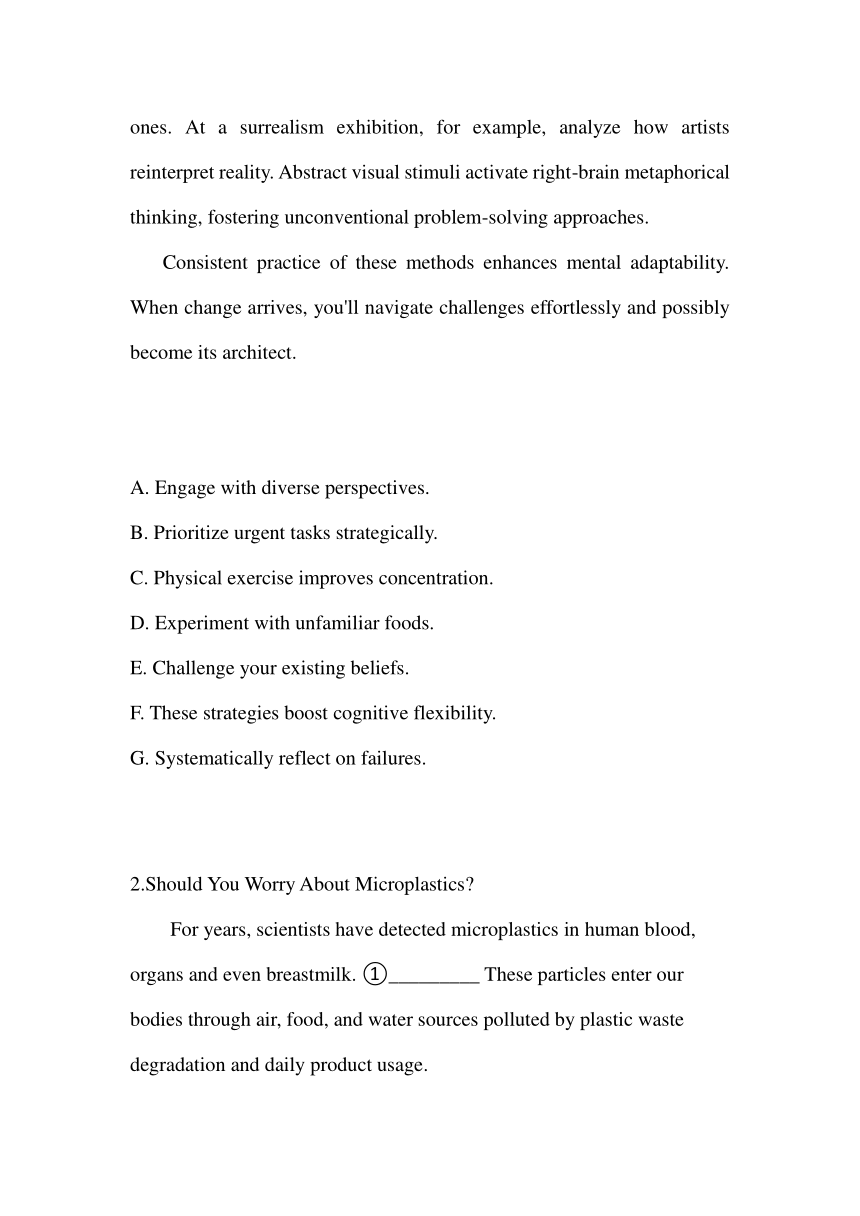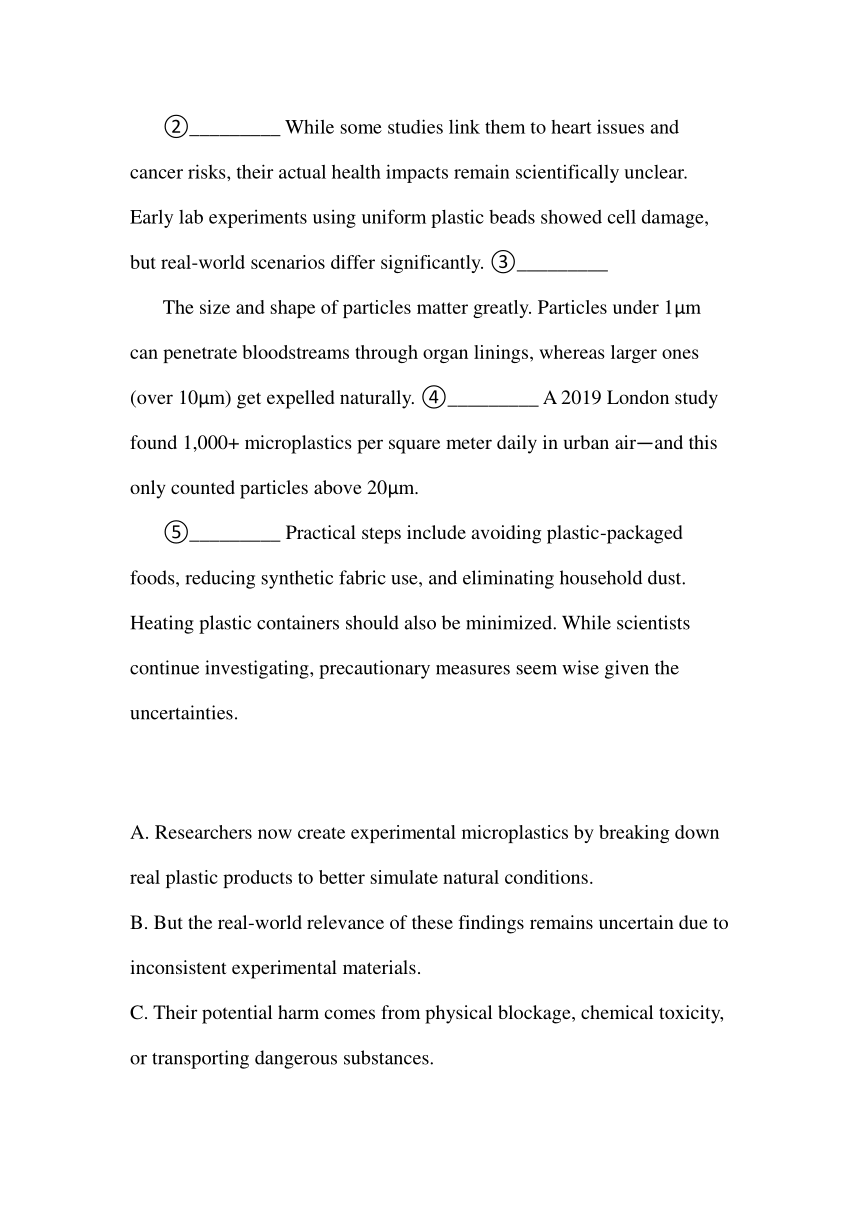外刊改编七选五三篇(五种激发思维的方法;微塑料的危害,为什么你爱听悲伤的音乐)(3篇,含答案)-2025届高三英语二轮复习
文档属性
| 名称 | 外刊改编七选五三篇(五种激发思维的方法;微塑料的危害,为什么你爱听悲伤的音乐)(3篇,含答案)-2025届高三英语二轮复习 |  | |
| 格式 | docx | ||
| 文件大小 | 19.6KB | ||
| 资源类型 | 教案 | ||
| 版本资源 | 人教版(2019) | ||
| 科目 | 英语 | ||
| 更新时间 | 2025-02-11 12:51:47 | ||
图片预览



文档简介
1.Elastic Thinking: 5 Ways to Thrive in Fast-Changing Times
In our rapidly evolving world, developing elastic thinking has become crucial. This mental flexibility allows us to adapt to changes and even drive innovation. Here are five research-backed methods to cultivate this ability.
(36)______ Select a daily concept opposing your beliefs and sincerely explore its validity. For instance, if you doubt vegetarianism, study related research and simulate supporters' reasoning. This practice breaks mental rigidity by challenging confirmation bias.
(37)______ While we often bury past errors, consciously revisiting significant mistakes proves valuable. Reconstruct scenarios where cognitive biases misled you. Confronting the "always-right" illusion creates space for flexible thinking.
(38)______ Visit randomly chosen restaurants and order least popular dishes. Neuroscience reveals that such minor adventures activate brain's association areas. Unfamiliar flavors stimulate new neural connections, boosting creative potential.
(39)______ Initiate conversations with culturally diverse individuals, especially those holding unconventional views. Focus on understanding their logic rather than refuting it. Exposure to multiple perspectives expands cognitive boundaries beyond textbook learning.
(40)______ Explore avant-garde art forms, even initially confusing ones. At a surrealism exhibition, for example, analyze how artists reinterpret reality. Abstract visual stimuli activate right-brain metaphorical thinking, fostering unconventional problem-solving approaches.
Consistent practice of these methods enhances mental adaptability. When change arrives, you'll navigate challenges effortlessly and possibly become its architect.
A. Engage with diverse perspectives.
B. Prioritize urgent tasks strategically.
C. Physical exercise improves concentration.
D. Experiment with unfamiliar foods.
E. Challenge your existing beliefs.
F. These strategies boost cognitive flexibility.
G. Systematically reflect on failures.
2.Should You Worry About Microplastics
For years, scientists have detected microplastics in human blood, organs and even breastmilk. ①_________ These particles enter our bodies through air, food, and water sources polluted by plastic waste degradation and daily product usage.
②_________ While some studies link them to heart issues and cancer risks, their actual health impacts remain scientifically unclear. Early lab experiments using uniform plastic beads showed cell damage, but real-world scenarios differ significantly. ③_________
The size and shape of particles matter greatly. Particles under 1 m can penetrate bloodstreams through organ linings, whereas larger ones (over 10 m) get expelled naturally. ④_________ A 2019 London study found 1,000+ microplastics per square meter daily in urban air—and this only counted particles above 20 m.
⑤_________ Practical steps include avoiding plastic-packaged foods, reducing synthetic fabric use, and eliminating household dust. Heating plastic containers should also be minimized. While scientists continue investigating, precautionary measures seem wise given the uncertainties.
A. Researchers now create experimental microplastics by breaking down real plastic products to better simulate natural conditions.
B. But the real-world relevance of these findings remains uncertain due to inconsistent experimental materials.
C. Their potential harm comes from physical blockage, chemical toxicity, or transporting dangerous substances.
D. Complete elimination of microplastics from modern life proves technically impossible with current technology.
E. Despite their widespread presence, understanding health consequences requires more targeted research.
F. Reducing exposure remains the most feasible solution for ordinary people.
G. What makes them concerning isn't their existence, but their unpredictable biological interactions.
3.Why Do We Enjoy Sad Music
Have you ever noticed that listening to sad songs can actually lift your mood ①_______ Let's explore the science behind this interesting phenomenon.
②_______ Studies show that people often choose melancholic melodies when feeling low. Surprisingly, this intentional exposure to sadness can serve two purposes: some seek emotional relief while others want to deepen their sad feelings.
③_______ Your personality, current emotions, and surroundings all shape your response. Brain scans reveal that multiple areas work together—including those handling emotions, artistic appreciation, and reward systems—to create your personal reaction.
But how does this psychological process work When sad music reminds us of painful memories, we might initially feel worse. ④_______ For many, reflecting on these memories helps them better understand their emotions. Additionally, sad music activates pleasurable psychological effects like emotional release, aesthetic enjoyment, and even dopamine production—a "feel-good" chemical in our brains.
⑤_______ Researchers explain that we recognize the sadness in music as separate from our real-life experiences. This distinction allows us to safely enjoy the emotional journey the music provides. So next time you're feeling blue, try playing a sorrowful ballad—it might be just what you need!
A. However, this sadness often transforms into comfort.
B. The answer lies in how our brains process emotions.
C. This contradictory behavior is more common than you think.
D. Sadness in music doesn't necessarily make us feel miserable.
E. Your reaction to sad music depends on three key factors.
F. Experts believe music preference reflects cultural background.
G. Scientists have found biological reasons for this phenomenon.
答案:1.EGDAF
2.正确答案: ①G ②C ③B ④E ⑤F
3.答案:①B ②C ③E ④A ⑤D
In our rapidly evolving world, developing elastic thinking has become crucial. This mental flexibility allows us to adapt to changes and even drive innovation. Here are five research-backed methods to cultivate this ability.
(36)______ Select a daily concept opposing your beliefs and sincerely explore its validity. For instance, if you doubt vegetarianism, study related research and simulate supporters' reasoning. This practice breaks mental rigidity by challenging confirmation bias.
(37)______ While we often bury past errors, consciously revisiting significant mistakes proves valuable. Reconstruct scenarios where cognitive biases misled you. Confronting the "always-right" illusion creates space for flexible thinking.
(38)______ Visit randomly chosen restaurants and order least popular dishes. Neuroscience reveals that such minor adventures activate brain's association areas. Unfamiliar flavors stimulate new neural connections, boosting creative potential.
(39)______ Initiate conversations with culturally diverse individuals, especially those holding unconventional views. Focus on understanding their logic rather than refuting it. Exposure to multiple perspectives expands cognitive boundaries beyond textbook learning.
(40)______ Explore avant-garde art forms, even initially confusing ones. At a surrealism exhibition, for example, analyze how artists reinterpret reality. Abstract visual stimuli activate right-brain metaphorical thinking, fostering unconventional problem-solving approaches.
Consistent practice of these methods enhances mental adaptability. When change arrives, you'll navigate challenges effortlessly and possibly become its architect.
A. Engage with diverse perspectives.
B. Prioritize urgent tasks strategically.
C. Physical exercise improves concentration.
D. Experiment with unfamiliar foods.
E. Challenge your existing beliefs.
F. These strategies boost cognitive flexibility.
G. Systematically reflect on failures.
2.Should You Worry About Microplastics
For years, scientists have detected microplastics in human blood, organs and even breastmilk. ①_________ These particles enter our bodies through air, food, and water sources polluted by plastic waste degradation and daily product usage.
②_________ While some studies link them to heart issues and cancer risks, their actual health impacts remain scientifically unclear. Early lab experiments using uniform plastic beads showed cell damage, but real-world scenarios differ significantly. ③_________
The size and shape of particles matter greatly. Particles under 1 m can penetrate bloodstreams through organ linings, whereas larger ones (over 10 m) get expelled naturally. ④_________ A 2019 London study found 1,000+ microplastics per square meter daily in urban air—and this only counted particles above 20 m.
⑤_________ Practical steps include avoiding plastic-packaged foods, reducing synthetic fabric use, and eliminating household dust. Heating plastic containers should also be minimized. While scientists continue investigating, precautionary measures seem wise given the uncertainties.
A. Researchers now create experimental microplastics by breaking down real plastic products to better simulate natural conditions.
B. But the real-world relevance of these findings remains uncertain due to inconsistent experimental materials.
C. Their potential harm comes from physical blockage, chemical toxicity, or transporting dangerous substances.
D. Complete elimination of microplastics from modern life proves technically impossible with current technology.
E. Despite their widespread presence, understanding health consequences requires more targeted research.
F. Reducing exposure remains the most feasible solution for ordinary people.
G. What makes them concerning isn't their existence, but their unpredictable biological interactions.
3.Why Do We Enjoy Sad Music
Have you ever noticed that listening to sad songs can actually lift your mood ①_______ Let's explore the science behind this interesting phenomenon.
②_______ Studies show that people often choose melancholic melodies when feeling low. Surprisingly, this intentional exposure to sadness can serve two purposes: some seek emotional relief while others want to deepen their sad feelings.
③_______ Your personality, current emotions, and surroundings all shape your response. Brain scans reveal that multiple areas work together—including those handling emotions, artistic appreciation, and reward systems—to create your personal reaction.
But how does this psychological process work When sad music reminds us of painful memories, we might initially feel worse. ④_______ For many, reflecting on these memories helps them better understand their emotions. Additionally, sad music activates pleasurable psychological effects like emotional release, aesthetic enjoyment, and even dopamine production—a "feel-good" chemical in our brains.
⑤_______ Researchers explain that we recognize the sadness in music as separate from our real-life experiences. This distinction allows us to safely enjoy the emotional journey the music provides. So next time you're feeling blue, try playing a sorrowful ballad—it might be just what you need!
A. However, this sadness often transforms into comfort.
B. The answer lies in how our brains process emotions.
C. This contradictory behavior is more common than you think.
D. Sadness in music doesn't necessarily make us feel miserable.
E. Your reaction to sad music depends on three key factors.
F. Experts believe music preference reflects cultural background.
G. Scientists have found biological reasons for this phenomenon.
答案:1.EGDAF
2.正确答案: ①G ②C ③B ④E ⑤F
3.答案:①B ②C ③E ④A ⑤D
